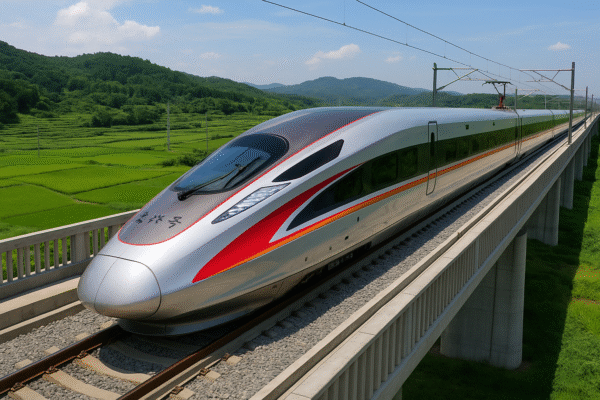China Sees Record-Breaking Summer Rail Travel Surge as High-Speed Routes Fuel Tourism Growth
China’s summer rail travel season has reached unprecedented levels, with over 260 million passengers recorded as of mid-July 2025, according to official data from China Railway. The country’s booming tourism industry has been supercharged by the expansion of its high-speed railway network, including the addition of new bullet trains and strategic route openings like the Chongqing-Xiamen high-speed line.
This summer marks a turning point in China’s rail-based tourism infrastructure. With increased mobility, faster routes, and greater accessibility to remote regions, both domestic and international travelers are embracing high-speed rail as the most efficient and scenic way to explore the country.
New Routes Redefining Regional Connectivity
At the center of this growth is the newly launched Chongqing-Xiamen high-speed railway, inaugurated in June 2025. This critical east-west link connects the mountainous city of Chongqing with the coastal tourist hub of Xiamen, significantly reducing travel time and opening access to secondary tourism cities along the route, such as Ganzhou, Nanchang, and Changsha.
With travel speeds reaching 350 km/h, this line enables tourists to reach cultural and nature-based attractions in less than half the time previously required. According to the Ministry of Transport of China, such infrastructure upgrades are crucial to regional economic development and sustainable tourism promotion.
Fuxing Bullet Trains Drive Speed and Comfort
To accommodate rising demand, China Railway Group has deployed additional Fuxing bullet trains, known for their cutting-edge design, enhanced energy efficiency, and world-class safety features. These trains—capable of traveling at 350 km/h—are currently operating at maximum capacity on key routes including Beijing–Shanghai, Chengdu–Chongqing, and now Chongqing–Xiamen.
Beyond sheer speed, these trains prioritize passenger experience. Features include ergonomic seating, Wi-Fi connectivity, advanced air purification systems, and real-time bilingual travel information, making them especially appealing to both business travelers and tourists.
Tourism Industry Benefits from Expanded Rail Access
The surge in passenger numbers is closely tied to a boom in domestic tourism. Popular summer travel regions like Sichuan, Fujian, Yunnan, and Hunan have seen a dramatic increase in rail arrivals, according to data from the China Tourism Academy. The tourism departments of these provinces have launched joint promotions with China Railway, including discounted rail-tour packages and family-friendly itinerary options.
Remote attractions—previously considered inaccessible—are now within easy reach. Sites like Wulong Karst in Chongqing, Gulangyu Island in Xiamen, and Zhangjiajie National Forest Park in Hunan are all experiencing tourism rebounds thanks to faster and more reliable rail links.
Rail Travel Meets the Rise of Self-Drive Tourism
In an innovative move to combine the efficiency of rail with the freedom of road travel, China’s railway system now offers vehicle transport services on select long-haul routes. Passengers can board with their private vehicles, which are transported in dedicated train compartments. Upon arrival, they can disembark and continue driving through scenic routes in provinces such as Xinjiang, Inner Mongolia, and Tibet.
This hybrid travel solution has been particularly attractive to young adventure-seeking travelers and families eager to explore lesser-known destinations on their own terms. It also aligns with China’s dual circulation tourism strategy, aimed at boosting domestic travel while preparing for international tourism recovery.
Government Investment and Green Growth
China’s rail travel boom is not accidental—it’s the result of sustained national investment in infrastructure under the 14th Five-Year Plan (2021–2025). The National Development and Reform Commission (NDRC) has prioritized high-speed rail development as a driver of equitable growth, low-carbon transport, and regional connectivity.
Rail remains one of the most sustainable modes of mass travel. According to the International Energy Agency (IEA), high-speed trains in China emit significantly less CO₂ per passenger-kilometer compared to air or highway travel. As China targets carbon neutrality by 2060, the expansion of its high-speed rail network plays a central role in reducing transport-sector emissions.
A Model for Global Tourism Mobility
China now operates the largest high-speed rail network in the world, spanning over 45,000 kilometers as of 2025, and its integration with regional tourism planning offers a model for other nations seeking to enhance sustainable travel. With cities and scenic regions increasingly connected via rail hubs, the nation continues to blend convenience, culture, and environmental responsibility.
Outlook for 2025 and Beyond
As the summer season continues, rail traffic is expected to increase further, potentially reaching 300 million passengers by August, based on forecasts from China State Railway Group Co., Ltd. The continuing rollout of new lines, combined with service innovations like car-on-train travel and digital ticketing platforms, ensures that China’s railways will remain the backbone of national tourism for years to come.
For travelers planning future journeys through China, the rail system offers a compelling blend of speed, comfort, and expansive access—from major metropolises to remote UNESCO World Heritage Sites. Whether it’s a weekend escape to Hangzhou’s West Lake, a multi-day trip to Silk Road destinations, or an eco-tour through Sichuan’s panda reserves, China’s high-speed trains make it possible to explore the country at record speed and scale.
For more travel news like this, keep reading Global Travel Wire















